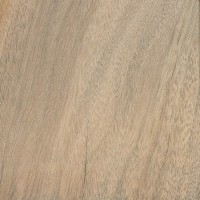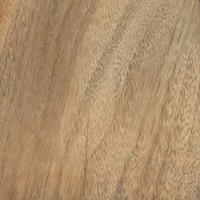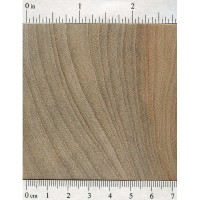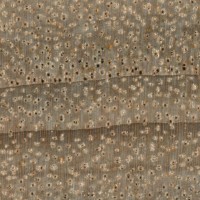 |
Common Name(s): Camphor, Camphor Laurel Scientific Name: Cinnamomum camphora Distribution: Native to southeast Asia, widely planted throughout tropical and subtropical regions worldwide Tree Size: 65-100 ft (20-30 m) tall, 2-4 ft (.6-1.2 m) trunk diameter Average Dried Weight: 33 lbs/ft3 (520 kg/m3) Specific Gravity (Basic, 12% MC): .43, .52 Janka Hardness: 950 lbf (4,440 N) Modulus of Rupture: 11,670 lbf/in2 (80.5 MPa) Elastic Modulus: 1,676,000 lbf/in2 (11.56 GPa) Crushing Strength: 5,820 lbf/in2 (40.1 MPa) Shrinkage: Radial: 3.1%, Tangential: 5.4%, Volumetric: 8.7%, T/R Ratio: 1.7 |
Color/Appearance: Color can be highly variable depending on species and growing conditions; generally a light brown, frequently with shades of gray, red, or olive green. Occasionally contains darker streaks. Paler sapwood isn’t always clearly differentiated from the heartwood. Burls are also commonly seen, and are considered highly decorative.
Grain/Texture: Grain can be straight, interlocked, and/or wavy. Uniform medium texture with a high natural luster and a slightly greasy feel.
Endgrain: Semi-ring porous or diffuse-porous; solitary and radial multiples; medium to large pores (two distinct sizes in semi-ring-porous samples) in no specific arrangement, few; tyloses occasionally present; parenchyma vasicentric, confluent; medium-width rays, spacing normal.
Rot Resistance: Rated as durable, with mixed resistance to various insect attacks.
Workability: Camphor’s moderate density makes it easy to shape and machine with minimal effort. Areas of interlocked grain may cause tearout issues, but complications are usually minimal. Glues and finishes well.
Odor: Camphor has a very characteristic odor, for which the tree is named. The most recognizable product that contains the extracts of camphor are medicated chest rubs, which have the same distinct scent.
Allergies/Toxicity: Camphor has been reported to cause skin and respiratory irritation, as well as a number of other effects, such as headaches, giddiness, and asthma-like symptoms. See the articles Wood Allergies and Toxicity and Wood Dust Safety for more information.
Pricing/Availability: Rarely, if ever exported, in lumber form, most Camphor is exported from Asia as burl veneer. Lumber, turning blanks, and log sections are sometimes seen for sale from domestic sources where the tree has been introduced and harvested locally. Prices for such “domestic” exotics are usually in the moderate range when compared to other imported hardwoods. Solid burls and veneer sheets are much more expensive.
Sustainability: Camphor is not listed in the CITES Appendices or on the IUCN Red List of Threatened Species, although a few related species, (Cinnamomum balansae from Vietnam, C. mercadoi from the Philippines, and C. osmophloeum from Taiwan), are listed as vulnerable/endangered due to a population reduction of over 20% to 50% in the past three generations, caused by a decline in its natural range, and exploitation.
Common Uses: Veneer, turned objects, chests, cabinetry, and furniture.
Comments: Perhaps known more famously for its beautiful burls, Camphor is also cultivated for its aromatic oils, which are used in a variety of culinary and medicinal applications. In addition to its medicinal values, the lingering scent of Camphor is also reported to inhibit silver from tarnishing and ward off moths, and the wood is sometimes used in trunks and chests where valuables are stored.
None available.
Scans/Pictures: A special thanks to Mike Leigher for providing the wood sample of this wood species.









I looked into this further. Although I don’t know how much camphor remains after the wood is dried, based on Den Socling’s comment below and articles by the National Institute of Health I ‘m going to steer clear of cutting boards made of camphor wood. For more information go to nih.gov and in the search box, type “camphor toxicity”.
Shirley, we have a camphor wood chest that is almost 40 years old and it still smells strongly of camphor.
Hi Shirley, I spoke to a very experienced timber merchant in Sydney when I was purchasing wood for a baby rattle. I also wanted to make a chopping board. His words were “Yes, it’s poisonous. If you can eat enough of a slab of camphor laurel to get sick or die, I’ll personally make your coffin.” Chopping boards have been made out of it in Australia for at least 40 years, due to it being a widely planted pest. If you see one you are not only allowed, but actively encouraged to log it, anywhere. The nature of it is… Read more »
Camphor is one of those woods that you love or shy away from due to the odor. I left some untreated pieces in my home and it smelled of camphor oil for a day. Personally, it is a bit irritating to my lungs.
But the burl is magnificent and the grain reminds me a bit of olive wood. To avoid the odor, I’ve sealed the pieces with hard finishes, not just oils. See attachment of a serving board I made with camphor and epoxy. It took 5 total pours to get the color and depth right.
very hard, but wonderful to work with sharp tools.
ive Been searching 10+ years for a good storage chest lined with real camphor wood! My parents have one where they store heirloom wool blankets and linens … everything comes out of it smelling beautiful and yes it keeps the moths and bugs away!
You could try a standard cedar lined chest and rub Vick’s vapo rub into the wood in a thin coat and let it dry outside for a week. Go easy at first, you can always add more later. There will be camphor oil in the rub.
Come to Jacksonville North Florida they are everywhere considered a noxious weed or shrub. There are some nice size Camphor Laurels scattered everywhere throughout this massive city they don’t take very well to the cold though when it snowed here in the 80s and killed off almost all of them. They grow like wildfire ants won’t get near them bugs won’t either natural insect repellent
my step brother has a house in springfield area of jax, with a giant one in back yard on property line. the trunk of it is several feet, i believe it was just left to grow from the 100 years old the house and property is. the limbs were growing sideways and almost a foot in diameter, a few large limbs had bad “deadness” in them and i cut them back with a chainsaw. i had no idea it was actually a camphor tree. i dried the logs and split them, they were used for campfire wood, the vapors of… Read more »
In Australia these trees are considered a weed and have taken over many areas. So we have a glut of the stuff available here. It does smell absolutely beautiful when you cut it and even when used as firewood.
We have 3 – given to us each sisters by our grandfather. I keep camphor cubes (found in Australia) in the chest as well….
Should an old camphor just be oiled?
My company has vacuum kilns in Australia that are drying Camphor Laurel. We discovered that the VOC’s out of the wood will dissolve PVC pipe. I urge anybody who tries to dry the species is very careful to use good ventilation.
Great wood. Can be found in Florida also. Best to sand it outside or with good dust collection as with all wood. Worst ever was Redwood from the redwood forests in California. Saw dust was like red baby powder. Used a high quality dust respirator and still had red muchus for a week. Camphor doesn’t bother me at all. Love the smell. My mother use to heat up a teaspoon of camphor oil for ear aches. i love the grain and mixtures of figure and burl’s. I only buy the slabs and finish with live edge
What’s that smell? …Camphor wood… Your guitar was made out of camphor wood – It must have been worth a fortune!
This is the precise reason I clicked on this page.
indeed, that was why Ai came to this site, too.
Bought a 3″x14″ camphor blank for a bowl. Turns easily, finishes easily, and made an attractive piece. Was astonished at the strength of the “vick’s vaporub” odor. No allergy problems, but sure opened up the sinuses. Odor lingered for weeks in my shop.
After milling a camphor log I developed a serious allergy reaction.
Eyes, eyelids upper and lowers are swelled up and swelling for the past 2 days.
Developed rashes on skin even though I had long sleeve shirt on.
Dust must have gotten under my eyelids and caused this severe reaction.
Hope this helps others to avoid this specie.
David
So glad I’ve read this 10 years later.